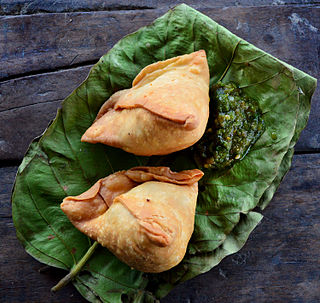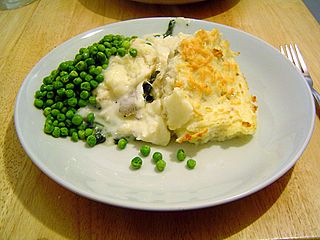Related Research Articles

A pie is a baked dish which is usually made of a pastry dough casing that contains a filling of various sweet or savoury ingredients. Sweet pies may be filled with fruit, nuts, fruit preserves, brown sugar, sweetened vegetables, or with thicker fillings based on eggs and dairy. Savoury pies may be filled with meat, eggs and cheese or a mixture of meat and vegetables.

Polish cuisine is a style of food preparation originating in and widely popular in Poland. Due to Poland's history, Polish cuisine has evolved over the centuries to be very eclectic, and shares many similarities with other national cuisines. Polish cooking in other cultures is often referred to as à la polonaise.

Pierogi or pierogies are filled dumplings, made by wrapping unleavened dough around a filling, and occasionally flavored with a savory or sweet garnish, finally cooked in boiling water.

A samosa is a fried central Asian pastry with a savoury filling, including ingredients such as spiced potatoes, onions, peas, meat, or fish. It is made into different shapes, including triangular, cone, or crescent, depending on the region. Samosas are often accompanied by chutney, and have origins in medieval times or earlier. Sweet versions are also made. Samosas are a popular entrée, appetizer, or snack in the cuisines of South Asia, the Middle East, Central Asia, East Africa and their South Asian diasporas.

Moussaka is an eggplant (aubergine)- or potato-based dish, often including ground meat, which is common in the Balkans and the Middle East, with many local and regional variations.

Trinidad and Tobago has a unique history and its food is influenced by Indian-South Asian, West African, Creole, European, American, Chinese, Amerindian, and Latin American culinary styles. Trinidadian and Tobagonian food is dominated by a wide selection of dishes, most notably, doubles, roti, pelau, callaloo and curried crab and dumplings. Trinidad and Tobago is also known for its prepared provisions, such as dasheen, sweet potato, eddoes, cassava, yam, soups and stews, also known as blue food across the country. Corresponding to the Blue Food Day event held annually in Trinidad and Tobago.

Torta is a culinary term that can, depending on the cuisine, refer to cakes, pies, flatbreads, sandwiches, or omelettes.

The Bedfordshire clanger is a dish from Bedfordshire and adjacent counties in England, such as Buckinghamshire and Hertfordshire. It dates back to at least the 19th century. It is still available at various bakers and served at some cafes, restaurants and local places of interest.

Scottish cuisine encompasses the cooking styles, traditions and recipes associated with Scotland. It has distinctive attributes and recipes of its own, but also shares much with other British and wider European cuisine as a result of local, regional, and continental influences—both ancient and modern.

Fish pie, also known as fisherman's pie, is a traditional British dish.

Homity pie is a traditional British open vegetable pie. The pastry case contains a filling of potatoes and an onion and leek mixture, which is then covered with cheese.

Faggots are meatballs made from minced off-cuts and offal mixed with herbs and sometimes bread crumbs. It is a traditional dish in the United Kingdom, especially South and Mid Wales and the English Midlands.

Cornish cuisine encompasses the cooking styles, traditions and recipes associated with Cornwall and the Cornish people. It has been heavily influenced by the geography of the county as well as its social history.

The Crimean Tatar cuisine is primarily the cuisine of the Crimean Tatars, who live on the Crimean Peninsula. The traditional cuisine of the Crimean Tatars has similarities with that of Greeks, Italians, Balkan peoples, Nogais, North Caucasians, and Volga Tatars, although some national dishes and dietary habits vary between different Crimean Tatar regional subgroups; for example, fish and produce are more popular among Yaliboylu and Tat dishes while meat and dairy is more prevalent in Steppe Tatar cuisine. Many Uzbek dishes were incorporated into Crimean Tatar national cuisine during exile in Central Asia since 1944, and these dishes have become prevalent in Crimea since the return. Uzbek samsa, laghman, and plov (pilaf) are sold in most Tatar roadside cafes in Crimea as national dishes. In turn, some Crimean Tatar dishes, including Chiburekki, have been adopted by peoples outside Crimea, such as in Turkey and the North Caucasus.

A croquette is a deep-fried roll originating in French cuisine, consisting of a thick binder combined with a filling, which is then breaded. It is served as a side dish, a snack, or fast food worldwide.

Dumpling is a broad class of dishes that consist of pieces of cooked dough, often wrapped around a filling. The dough can be based on bread, wheat or other flours, or potatoes, and it may be filled with meat, fish, tofu, cheese, vegetables, or a combination. Dumplings may be prepared using a variety of cooking methods and are found in many world cuisines.
References
- ↑ Hopkinson, Simon (2002-04-16). "Cheese and onion pie - Recipes - Food & Drink". The Independent . Archived from the original on December 2, 2008. Retrieved 2012-02-15.
- ↑ Marks, David. "Recipe for Traditional Cheese and Onion Pie". Cookuk.co.uk. Retrieved 14 March 2013.
- ↑ "heidi – Pieminister". Pieminister.co.uk. Retrieved 6 January 2018.